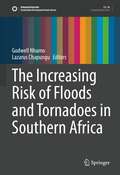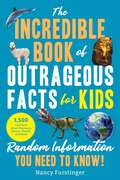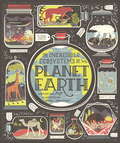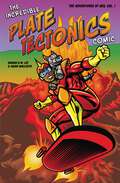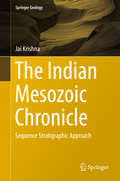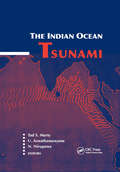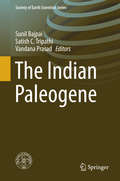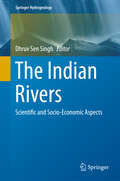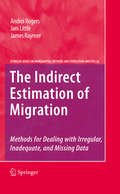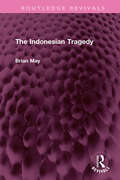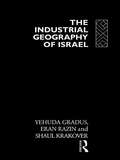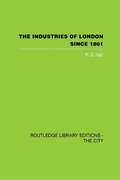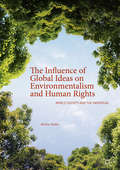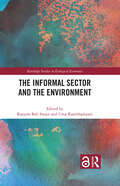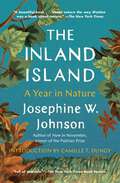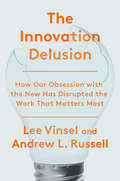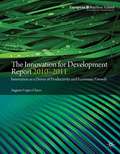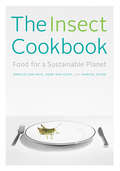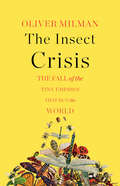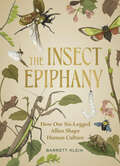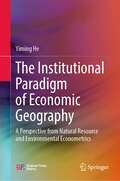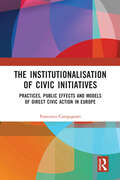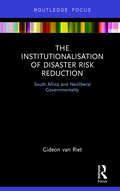- Table View
- List View
The Increasing Risk of Floods and Tornadoes in Southern Africa (Sustainable Development Goals Series)
by Godwell Nhamo Lazarus ChapunguThis volume discusses the increasing occurrence of floods and tornadoes in Southern Africa over the last few years. The book discusses existing flood and tornado management protocols, indigenous approaches to mitigate disaster risk, urban and peri-urban flooding, tornado-induced flooding and windstorms, and the challenges and vulnerabilities associated with rural and transboundary floods. The book offers planning and recovery strategies to minimise impacts from these events through sustainable means. Such means include sustainable drainage systems, waste management in harbors and beaches, community engagement in flood-prone areas, and improved food security measures in urban poor households.
The Incredible Book of Outrageous Facts for Kids: Random Information You Need to Know!
by Nancy FurstingerKids love to read astonishing, absurd, and amusing facts such as these and then share them with their families and friends. Amazingly pointless, but verified, factoids will gear kids up to master Jeopardy and win at family trivia nights. Chapters will feature categories with kid-appeal, including animals, sports, planets, dinosaurs, toys, technology, strange foods, superheroes, unusual pets, fashion, movies, weather, and more. Every time kids pick up this book, they&’ll learn something new. (Parents also might grab this book as a boredom buster.) Did you know . . . a blue whale&’s tongue weighs nearly 6,000 pounds, about as heavy as an Asian elephant the world&’s first underwater post office operated on the sea floor of the Bahamas in 1939 pogonophobia is the fear of beards (perhaps spurred by a study showing that beards contain more bacteria than dog fur) (Well, now you do!)
The Incredible Ecosystems of Planet Earth
by Rachel IgnotofskyAn illustrated tour of our planet's ecosystems both large and small, from reefs, deserts and rainforests to a single drop of water - from the bestselling author of Women in Science. Through exquisite illustrations, maps and infographics, bestselling author Rachel Ignotofsky explains how our planet works, from its incredible ecosystems and the plants and animals that live there to the importance of biodiversity, weather cycles and more. Including information on the dangers of climate change and ideas for how to protect Planet Earth, this utterly charming guide is the perfect gift for all nature-loving readers on the planet we call home.
The Incredible Plate Tectonics Comic: The Adventures of Geo, Vol. 1
by Adam Wallenta Kanani K. LeeThe Incredible Plate Tectonics Comic is a wild adventure in earth science. Follow Geo and his robot dog, Rocky, as they travel back in time to Pangea, surf a tsunami, and escape an erupting volcano—all in time for Geo’s first-period science test!The journey starts 200 million years ago and takes you to modern-day Hawai’i, the ocean floor, and deep inside the Earth.You’ll learn:–How scientists developed the theory of plate tectonics–Why the Earth shakes–What’s in the center of the Earth–How volcanoes can form islandsThe Incredible Plate Tectonics Comic will teach you about geology in a fun, lively, and visual way.Ages 8+. Recommended for grade 6 and up
The Indian Mesozoic Chronicle
by Jai KrishnaThe book reviews and summarizes the Indian Mesozoic geological evolution in an innovative alternative perspective of sequence stratigraphy. It mainly focuses on the Jurassic interval, but also concisely discusses the preceding Triassic and Cretaceous geological records. The key to the study is primarily held in the recently developed ammonoid based high resolution scales in the Triassic and Jurassic period. The Indian Jurassic record is thus elevated to a high resolution pedestal. The large intra-Jurassic stratigraphic gap in Kachchh, with increase in duration from margin to basin, has been pr#65533;cised in different sections, along with radical revision of its long held interpretation from sub-aerial to sub-marine all over from Arabia to Australia. Other significant gaps are also differentiated into sub-aerial and sub-marine. The Indian Late Precambrian - Neogene record is organized into five mega-sequences. Among these, the fourth - also the most important one - includes the intra-Permian to Early Eocene interval from the origin to the closure of the Neotethys. Based on multidisciplinary integration of the Indian Mesozoic geological record and comparison with hydrocarbon producing basins on east and west of India, a highly positive scenario of the hydrocarbon source/reservoir sediment perspective is outlined in the book in sequence stratigraphic backdrop as an edifice for future elaborate evaluation.
The Indian Ocean Tsunami
by U. Aswathanarayana Tad S. Murty Niru NirupamaThe Indian Ocean tsunami of December 2004 is considered to have been one of the worst natural disasters in history, affecting twelve countries, from Indonesia to Somalia. 175,000 people are believed to have lost their lives, almost 50,000 were registered as missing and 1.7 million people were displaced. As well as this horrendous toll on human life
The Indian Paleogene (Society Of Earth Scientists Ser.)
by Sunil Bajpai Satish C. Tripathi Vandana PrasadThis unique book provides a concise account of Indian Paleogene and presents a unified view of the Paleogene sequences of India. The Paleogene, comprising the early part of the Cenozoic Era, was the most dynamic period in the Earth’s history with profound changes in the biosphere and geosphere. The period spans ~42 million years, beginning from post- K/T mass extinction event at ~65 Ma and ending at ~23 Ma, when the first Antarctic ice sheet appeared in the Southern Hemisphere. The early Paleogene (Paleocene–Eocene) has been considered a globally warm period, superimposed on which were several transient hyperthermal events of extreme warmth. Of these, the Palaeocene Eocene Thermal Maxima (PETM) boundary interval is the most prominent extreme warming episode, lasting 200 Ka. PETM is characterized by 2–6‰ global negative carbon isotope excursion. The event coincided with the Benthic Extinction Event (BEE) in deep sea and Larger Foraminifera Turnover (LFT) in shallow seas. Rapid ~60–80 warming of high latitudinal regions led to major faunal and floral turnovers in continental, shallow-marine and deep-marine areas. The emergence and dispersal of mammals with modern characteristics, including Artiodactyls, Perissodactyls and Primates (APP), and the evolution and expansion of tropical vegetation are some of the significant features of the Paleogene warm world.In the Indian subcontinent, the beginning and end of the Paleogene was marked by various events that shaped the various physiographic features of the Indian subcontinent. The subcontinent lay within the equatorial zone during the earliest part of the Paleogene. Carbonaceous shale, coal and lignite deposits of early Eocene age (~55.5–52 Ma) on the western and north-eastern margins of the Indian subcontinent are rich in fossils and provide information on climate as well as the evolution and paleobiogeography of tropical biota. Indian Paleogene deposits in the India–Asia collision zone also provide information pertaining to the paleogeography and timing of collision. Indian Paleogene rocks are exposed in the Himalayan and Arakan mountains; Assam and the shelf basins of Kutch–Saurashtra, Western Rajasthan; Tiruchirappalli–Pondicherry and Andaman and, though aerially limited, these rocks bear geological evidence of immense importance.
The Indian Rivers: Scientific and Socio-economic Aspects (Springer Hydrogeology)
by Dhruv Sen SinghThe book presents geomorphological studies of the major river basins - the Indus, Ganga and Brahmaputra and their tributaries. Besides major basins, the book explores peninsular rivers and other rivers state-by-state. All types of rivers, i. e. snow-fed, rain-fed and groundwater-fed rivers are explained together in geological framework. Rivers are lifeline and understanding of the rivers, their dynamics, science and socio-economic aspect is very important. However, different sources provide different data base for rivers. But a book which explains all major rivers of a country at a single place was not yet available. This book is the first book of its kind in the world which provides expert opinion on all major rivers of a country like India. This book complements works in these areas for the last two to three decades on major rivers of India by eminent professors and scientists from different universities, IITs and Indian research institutions. The information presented in the book would appeal to a wider readership from students, teachers to researchers and planners engaged in developmental work and also to common people of the society concerned with awareness about rivers.
The Indirect Estimation of Migration
by Jani Little Andrei Rogers James RaymerThis unique book introduces an essential element in applied demographic analysis: a tool-kit for describing, smoothing, repairing and - in instances of totally missing data - inferring directional migration flows. Migration rates combine with fertility and mortality rates to shape the evolution of human populations. Demographers have found that all three generally exhibit persistent regularities in their age and spatial patterns, when changing levels are controlled for. Drawing on statistical descriptions of such regularities, it is often possible to improve the quality of the available data by smoothing irregular data, imposing the structures of borrowed and related data on unreliable data, and estimating missing data by indirect methods. Model migration schedules and log-linear models are presented as powerful methods for helping population researchers, historical demographers, geographers, and migration analysts work with the data available to them.
The Indonesian Tragedy (Routledge Revivals)
by Brian MayFirst published in 1978, The Indonesian Tragedy is a controversial book that argues that Indonesia’s lack of economic development is due to the blind attempt to force a Western economic model on a population, whose culture and psychology are unsuited to it. The author demonstrates the ‘Indonesian Tragedy’ not so much by argument, as by depicting the country as he experienced it day to day. In developing his conclusion, he draws on history, and the works of sociologists, some of whom he disagrees with. In this way he sheds light on the predicament of Indonesia and helps to illuminate a problem common to much of the Third World. This book will be of interest to students of history, sociology, journalism, and Southeast Asian studies.
The Indoor Environment Handbook: How to Make Buildings Healthy and Comfortable
by Philomena BluyssenWinner of the Choice Outstanding Academic Titles of 2010 award. Ensuring that buildings are healthy and comfortable for their occupants is a primary concern of all architects and building engineers. This highly practical handbook will help make that process more efficient and effective. It begins with a guide to how the human body and senses react to different indoor environmental conditions, together with basic information on the parameters of the indoor environment and problems that can occur. It then moves on to give a background to the development of the study and control of the indoor environment, examining the main considerations (including thermal, lighting, indoor air and sound-related aspects) for a healthy and comfortable indoor environment and discussing the drivers for change in the field. The final section presents a new approach towards health and comfort in the indoor environment, where meeting the wishes and demands of the occupants with a holistic strategy becomes the over-riding priority. The book is filled with useful facts, figures and analysis, and practical methods that designers who are keen to assess and improve the user experience of their buildings will find invaluable.
The Industrial Geography of Israel
by Eran Razin Yehuda Gradus Shaul KrakoverIsrael's industrial geography is unique. The continuing Arab-Israeli conflict has been a primary force behind government intervention in settlement patterns, and has led to a major effort to disperse industry. The geopolitical situation has also encouraged a policy of attempted self-reliance, especially for defence purposes. These factors, combined with an abundant human capital, have given Israeli high-technology industries a special place in the international division of labour. The absorption of waves of mass immigration has influenced industrial development. Rural industrialisation, mainly by the Kibbutz (communal settlement) movement, is another unique feature. The Industrial Geography of Israel presents a comprehensive overview of industrial spatial development of Israel from the Ottoman era to present times, evaluating industrial dispersal policy, corporate geography, high-technology industries, entrepreneurship and rural industrial development. The spatial development of Israeli industry is set within the broader context of Israel's political and economic development and of global economic change, as well as theories of industrial location and regional planning and development.
The Industries of London Since 1861
by P.G. HallHall argues that 'London was the chief manufacturing centre of the country in 1861, and without doubt for centuries before that'. This book looks at industries in London over time from 1861. This book was first published in 1962.
The Influence of Global Ideas on Environmentalism and Human Rights
by Markus HadlerThis book explores whether individual attitudes and behaviors are swayed by global developments in a world increasingly populated by organizations, treaties, and other institutions that focus on environmentalism and human rights. It uses the sociological approach of World Society theory to investigate the effects of global ideas on individual environmentalism, xenophobia, and homophobia while drawing its data from a variety of international public opinion surveys. The Influence of Global Ideas on Environmentalism and Human Rights questions the dominant narrative of World Society related research as a positive influence of global ideas on various outcomes. Hadler demonstrates the complexity of this issue through empirical analyses revealing mixed trends in attitudes and behaviors from around the world. This book will be of interest to academics seeking to critically engage with World Society theory through two of its core topics: human rights and environmentalism.
The Informal Sector and the Environment (Routledge Studies in Ecological Economics)
by Ranjula Bali SwainThe informal economy – broadly defined as economic activity that is not subject to government regulation or taxation – sustains a large part of the world's workforce. It is a diverse, complex and growing area of activity. However, being largely unregulated, its impact on the environment has not been closely scrutinised or analysed. This edited volume demonstrates that the informal sector is a major source of environmental pollution and a major reason behind the environmental degradation accompanying the expansion of economic activity in developing countries. Environmental regulation and economic incentive policies are difficult to implement in this sector because economic units are unregistered, geographically dispersed and difficult to identify. Moreover, given their limited capital base, they cannot afford to pay pollution fees or install pollution abating equipment. Informal manufacturing units often operate under unscientific and unhealthy conditions, further contributing to polluting the environment. The book emphasizes and examines these challenges, and their solutions, encountered in various sectors of the informal economy, including urban waste pickers, small-scale farmers, informal workers, home-based workers, street vendors, and more. If the informal sector is to "Leave no one behind" (as the Sustainable Development Goals promise) and contribute to "inclusive growth" (an objective of the green economy), then its impact on the economy as well as the environment has to be carefully considered. This book marks a significant contribution to the literature on both the informal economy and sustainable development, and will be of great interest to readers in economics, geography, politics, environment studies and public policy more broadly.
The Inland Island: A Year in Nature
by Josephine Johnson&“A beautiful book...about nature the way Walden was a book about nature. It should be read by everyone who still retains the capacity to feel anything&” (The New York Times). Stunningly written and fiercely observed, a new edition of a classic work of nature writing about a year on an Ohio farm, by Pulitzer Prize–winning author Josephine Johnson.Originally published in 1969, The Inland Island is Josephine W. Johnson&’s startling and brilliant chronicle of nature and the seasons at her rambling thirty-seven-acre farm in Ohio, which she and her husband reverted to wilderness with the help of a state forester. Over the course of twelve months, she observes the changing landscape with a naturalist&’s precision and a poet&’s evocative language. Readers will marvel at the way she brings to life flashes of beauty, the inexorable cycle of growth and decay, and the creatures who live alongside her, great and small. A forerunner of iconic American women nature writers and a champion of civil rights who marched in Washington against the Vietnam war, Johnson intersperses these &“delicate marvels&” (The New York Times) with profound reflections about racial inequality, urbanization, social justice, and environmental destruction that speak powerfully to our time. Ready to be rediscovered by a new generation, The Inland Island is a vital and relevant meditation on nature and time, capturing the wonder, beauty, hope—and flaws—of our turbulent world.
The Innovation Delusion: How Our Obsession with the New Has Disrupted the Work That Matters Most
by Andrew L. Russell Lee VinselInnovation is the hottest buzzword in business. But what if our obsession with finding the next big thing has distracted us from the work that matters most?&“The most important book I&’ve read in a long time . . . It explains so much about what is wrong with our technology, our economy, and the world, and gives a simple recipe for how to fix it: Focus on understanding what it takes for your products and services to last.&”—Tim O&’Reilly, founder of O&’Reilly Media It&’s hard to avoid innovation these days. Nearly every product gets marketed as being disruptive, whether it&’s genuinely a new invention or just a new toothbrush. But in this manifesto on thestate of American work, historians of technology Lee Vinsel and Andrew L. Russell argue that our way of thinking about and pursuing innovation has made us poorer, less safe, and—ironically—less innovative. Drawing on years of original research and reporting, The Innovation Delusion shows how the ideology of change for its own sake has proved a disaster. Corporations have spent millions hiring chief innovation officers while their core businesses tank. Computer science programs have drilled their students on programming and design, even though theoverwhelming majority of jobs are in IT and maintenance. In countless cities, suburban sprawl has left local governments with loads of deferred repairs that they can&’t afford to fix. And sometimes innovation even kills—like in 2018 when a Miami bridge hailed for its innovative design collapsed onto a highway and killed six people. In this provocative, deeply researched book, Vinsel and Russell tell the story of how we devalued the work that underpins modern life—and, in doing so, wrecked our economy and public infrastructure while lining the pockets of consultants who combine the ego of Silicon Valley with the worst of Wall Street&’s greed. The authors offer a compelling plan for how we can shift our focus away from the pursuit of growth at all costs, and back toward neglected activities like maintenance, care, and upkeep. For anyone concerned by the crumbling state of our roads and bridges or the direction our economy is headed, The Innovation Delusion is a deeply necessary reevaluation of a trend we can still disrupt.
The Innovation for Development Report 2010–2011: Innovation as a Driver of Productivity and Economic Growth
by A. López-ClarosThis report provides a comprehensive look at the role of innovation in promoting economic and social development. It examines the impact of innovation on the economic growth of developing countries and the future role of technological innovation in international efforts to mitigate the effects of climate change, amongst many other issues.
The Insect Cookbook
by Marcel Dicke Françoise Takken-Kaminker Arnold Van Huis Henk Van Gurp Diane Blumenfeld-SchaapInsects will be appearing on our store shelves, menus, and plates within the decade. In The Insect Cookbook, two entomologists and a chef make the case for insects as a sustainable source of protein for humans and a necessary part of our future diet. They provide consumers and chefs with the essential facts about insects for culinary use, with recipes simple enough to make at home yet boasting the international flair of the world's most chic dishes.Insects are delicious and healthy. A large proportion of the world's population eats them as a delicacy. In Mexico, roasted ants are considered a treat, and the Japanese adore wasps. Insects not only are a tasty and versatile ingredient in the kitchen, but also are full of protein. Furthermore, insect farming is much more sustainable than meat production. The Insect Cookbook contains delicious recipes; interviews with top chefs, insect farmers, political figures, and nutrition experts (including chef René Redzepi, whose establishment was elected three times as "best restaurant of the world"; Kofi Annan, former secretary-general of the United Nations; and Daniella Martin of Girl Meets Bug); and all you want to know about cooking with insects, teaching twenty-first-century consumers where to buy insects, which ones are edible, and how to store and prepare them at home and in commercial spaces.
The Insect Cookbook: Food for a Sustainable Planet (Arts and Traditions of the Table: Perspectives on Culinary History)
by Marcel Dicke Arnold van Huis Henk van GurpThe Definitive Guide to Insects as a Sustainable Food SourceIn The Insect Cookbook, two entomologists and a chef make the case for insects as a sustainable source of protein for humans and a necessary part of our future diet. They provide consumers and chefs with the essential facts about insects for culinary use, with recipes simple enough to make at home yet boasting the international flair of the world's most chic dishes."Invite politicians to dinner and let them tell the world how delicious it is.... They will proudly go around and say, 'I ate crickets, I ate locusts, and they were delicious.'"—Kofi Annan The Insect Cookbook features delicious recipes and interviews with top chefs, insect farmers, political figures, and nutrition experts, including chef René Redzepi, whose establishment was elected three times as "best restaurant of the world"; Kofi Annan, former secretary-general of the United Nations; and Daniella Martin of Girl Meets Bug. The book contains all you need to know about cooking with insects, where to buy them, which ones are edible, and how to store and prepare them at home and in commercial spaces.
The Insect Crisis: The Fall of the Tiny Empires That Run the World
by Oliver MilmanA devastating examination of how collapsing insect populations worldwide threaten everything from wild birds to the food on our plate. From ants scurrying under leaf litter to bees able to fly higher than Mount Kilimanjaro, insects are everywhere. Three out of every four of our planet’s known animal species are insects. In The Insect Crisis, acclaimed journalist Oliver Milman dives into the torrent of recent evidence that suggests this kaleidoscopic group of creatures is suffering the greatest existential crisis in its remarkable 400-million-year history. What is causing the collapse of the insect world? Why does this alarming decline pose such a threat to us? And what can be done to stem the loss of the miniature empires that hold aloft life as we know it? With urgency and great clarity, Milman explores this hidden emergency, arguing that its consequences could even rival climate change. He joins the scientists tracking the decline of insect populations across the globe, including the soaring mountains of Mexico that host an epic, yet dwindling, migration of monarch butterflies; the verdant countryside of England that has been emptied of insect life; the gargantuan fields of U.S. agriculture that have proved a killing ground for bees; and an offbeat experiment in Denmark that shows there aren’t that many bugs splattering into your car windshield these days. These losses not only further tear at the tapestry of life on our degraded planet; they imperil everything we hold dear, from the food on our supermarket shelves to the medicines in our cabinets to the riot of nature that thrills and enlivens us. Even insects we may dread, including the hated cockroach, or the stinging wasp, play crucial ecological roles, and their decline would profoundly shape our own story. By connecting butterfly and bee, moth and beetle from across the globe, the full scope of loss renders a portrait of a crisis that threatens to upend the workings of our collective history. Part warning, part celebration of the incredible variety of insects, The Insect Crisis is a wake-up call for us all.
The Insect Epiphany: How Our Six-Legged Allies Shape Human Culture
by Barrett KleinFrom entomologist Barrett Klein comes a buzz-worthy exploration of the many ways insects have affected human society, history, and culture Insects surround us. They fuel life on Earth through their roles as pollinators, predators, and prey, but rarely do we consider the outsize influence they have had on our culture and civilization. Their anatomy and habits inform how we live, work, create art, and innovate. Featuring nearly 250 color images—from ancient etchings to avant-garde art, from bug-based meals to haute couture—The Insect Epiphany proves that our world would look very different without insects, not just because they are crucial to our ecosystems, but because they have shaped and inspired so many aspects of what makes us human.
The Institutional Paradigm of Economic Geography: A Perspective from Natural Resource and Environmental Econometrics
by Yiming HeThis groundbreaking book offers a comprehensive and contemporary analysis of the major areas of institutional economic geography. Each chapter discusses in detail the new developments and changes in the field, and with a balance of theory, applications and empirical tests provides a rigorous grounding in the economic analysis of the natural resources and environmental issues that are increasingly prominent policy concerns. The book is a must-read for any social scientist interested in real-world economic geography and institutional economics, including economists, political scientists, sociologists, historians, geographers and anthropologists.
The Institutionalisation of Civic Initiatives: Practices, Public Effects and Models of Direct Civic Action in Europe
by Francesco CampagnariThis book examines two civic initiatives in Europe and analyses their evolution through the institutionalisation of their practices, local public effects, and established models for action at broader scales.Drawing from the concepts of civic action, problematic situations, public problems, and experience, this book coins the concept of direct civic action to explore civic initiatives beyond sectorial categories. It draws from the histories, everyday activities, and encounters with new problematic situations of a Slovak and a French initiative. It analyses the institutionalisation of their internal practices, their public cultural services, the models for action they establish in broader networks of initiatives, and how institutionalisation affects their experimentation and innovation. This book uses two case studies of civic initiatives in France and Slovakia, examining how the experimental and institutionalised approaches to problematic situations of civic initiatives are associated with the generation and continuative reproduction of public goods and policies. It also explores how local initiatives establish national and international networks and models for direct civic action.This book is aimed at scholars interested in civic initiatives, urban planning, public policies, innovation studies, and urban sociology. It is intended to engage members of civic initiatives by offering insights into organisational dynamics and their impact on public issues. Furthermore, it appeals to public officials and policy-makers who aim to establish policies that promote civic initiatives and encourage direct civic action.
The Institutionalisation of Disaster Risk Reduction: South Africa and Neoliberal Governmentality (Routledge Studies in Hazards, Disaster Risk and Climate Change)
by Gideon van RietThe past three decades have seen a global shift in disaster management from an event driven response to a ‘could-be’ risk management approach. Disaster risk reduction (DRR) has become entrenched as a dominant paradigm within the field of disaster management. More than a decade after adopting DRR legislation in South Africa there remains a dearth of evidence that this has translated into substantive action. This book examines the institutionalisation of DRR in South Africa, conceived of as a political economy of knowledge production. Using a critical theory approach, the book does not consider why DRR is failing but instead asks ‘why DRR?’ As such, it explores possibilities beyond DRR’s narrow optic and offers new insights into disaster management through the lens of South Africa. This is valuable reading for graduate students and academics working in disaster studies, geography, public policy and development/post-development studies, as well as policy makers.
